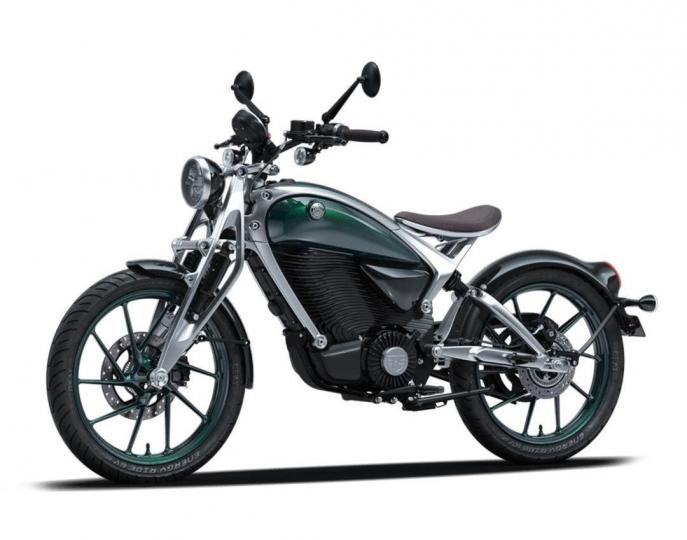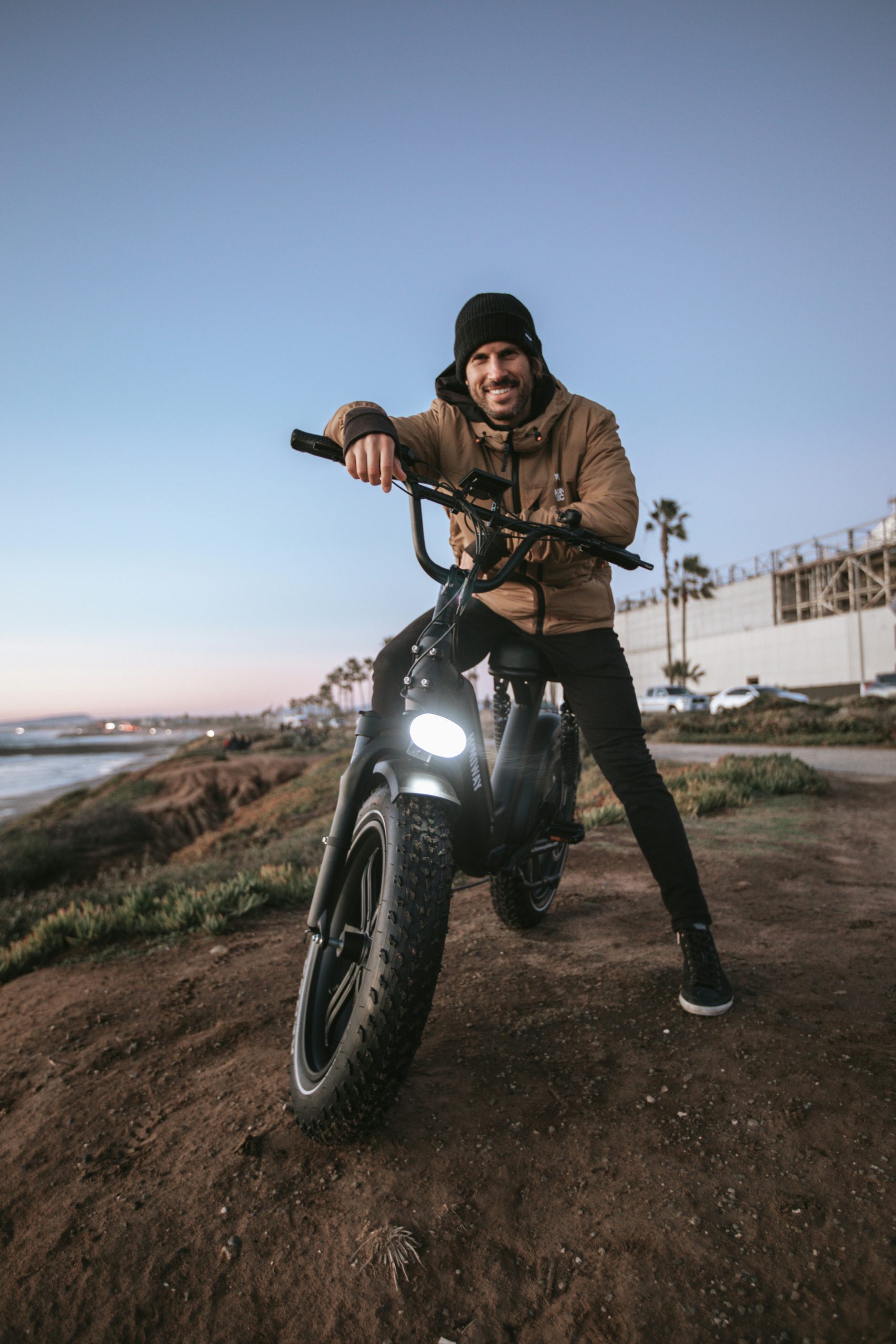We write this just a few weeks after Royal Enfield unveiled the Flying Flea sub-brand and the C6 and S6 motorcycles at EICMA 2024.
Royal Enfield makes 350cc air-cooled singles, 450cc liquid-cooled singles, and 650cc air-cooled twins.
RE stands for calm
Nearly all of these motorcycles have a signature exhaust note. So ‘signaturish’ is the exhaust note to the brand that IG influencers talk about it first thing in their reviews. For the singles in the range, it is what the motorcyclists would call a ‘British Thump.’
The exhaust note and some other traditional traits—vibrations, a relaxed nature, and happiness at slow speeds—have made RE what it is today—the largest lifestyle motorcycle brand in the world. REs have traditionally been made to give the rider a relaxed riding experience. It’s motorcycling with much show, a little go, and a prevalent sense of calm.
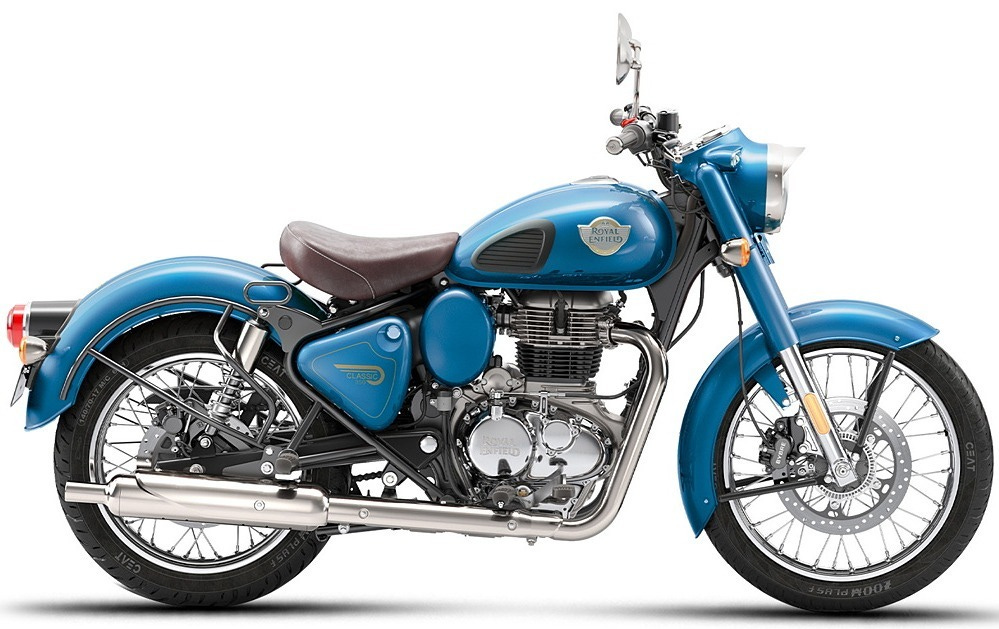
If one looks at it critically, RE is a brand established on its heritage credentials and plays safe. There are no experiments—there is not a single RE that can be called sporty. Everything is made for relaxed riding.
With one character trait—sportiness—never in the equation, RE has made the rest of its canvas vivid. They have been focused on things that they know they can do well:
- Appeal to the wannabe motorcyclist.
- Make their motorcycles look good while standing still because #1
- Use larger wheels (19”/18”) instead of 17”/17” for greater road presence, because #1
- Worked hard on CMF because #1
- Be easy for the wannabe to operate – so remove the Ural-like difficulties and bring in ease of operations like a slicker gearbox, a lighter clutch, and an electric start…because #1
- Bring the quality to acceptable levels. Over the last decade, the legends of RE’s oil leaks and other quality issues have subsided considerably. Again, needed for #1.
As a result, RE sales have stayed healthy, and the brand has become the largest lifestyle motorcycle brand in the world if a GBP 4500-7000 price range is considered lifestyle. The brand’s FY 2024 (Apr 2023- Mar 2024) sales were 913k units, a healthy number for any lifestyle brand worldwide.
How healthy?
That 913k is nearly the same as BMW Motorrad, KTM, Harley-Davidson, Indian, Triumph, Ducati, Aprilia, Moto Guzzi, and MV Agusta combined.
That’s not a fair comparison. In terms of price, an R 1300GS is equal to four RE Classic 350s.
But that’s also a fair comparison – a lifestyle customer is a lifestyle customer.
Mastering the art of targeting micro-niches
With nearly 15 models in the showroom and plenty more on the way, Royal Enfield has also mastered the art of targeting micro-niches, something it has learned well from Triumph and BMW. RE has been selling 13 models and more variants using three engines and three main-frames. More models are in the pipeline. That’s significant production complexity with only one main manufacturing plant.
RE’s model strategy is impressive in targeting micro-niches. To illustrate:
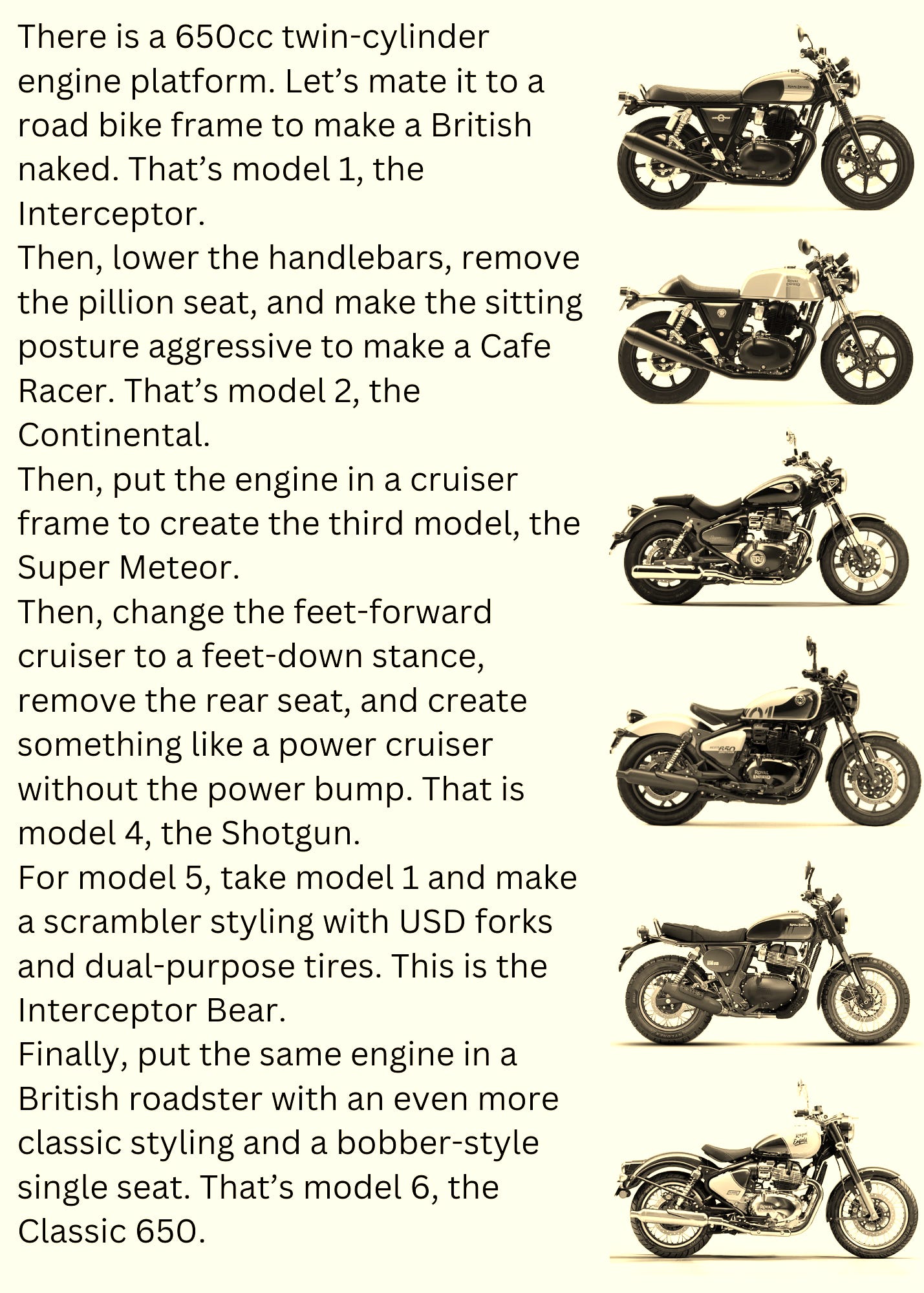
In doing all this, RE designers (some of whom would have come from the UK neighbor Triumph) have picked a leaf from Triumph. These learnings would carry forward into the Flying Flea as RE would likely build a range of motorcycles around a few motor-battery combinations around a single E&E architecture.
India focused
Royal Enfield is a fairly global company. It has an engineering center in Bruntingthorpe, UK, and multiple CKD assembly plants in South America. For years, it has been actively sold in Europe and North America, and the international motorcycling media recalls the brand well. Many of RE’s new models, especially the 650cc twin-cylinder range, have been designed with the global audience in mind—it is too expensive for the Indian market.
The lifestyle motorcycle market is changing, and RE saw an opportunity as buyers moved from high-performance, aggressive motorcycles to more relaxed, leisure riding. A few years ago, RE saw an opportunity, and the development of most of the current platforms started with the idea of tapping the global markets with affordable yet lifestyle motorcycles.
Yet, despite all the international posturing, RE’s international dispatches were only 9 percent of overall sales. Worryingly, the international share in sales has come down over the last two years—it was 14 percent in FY 2022.
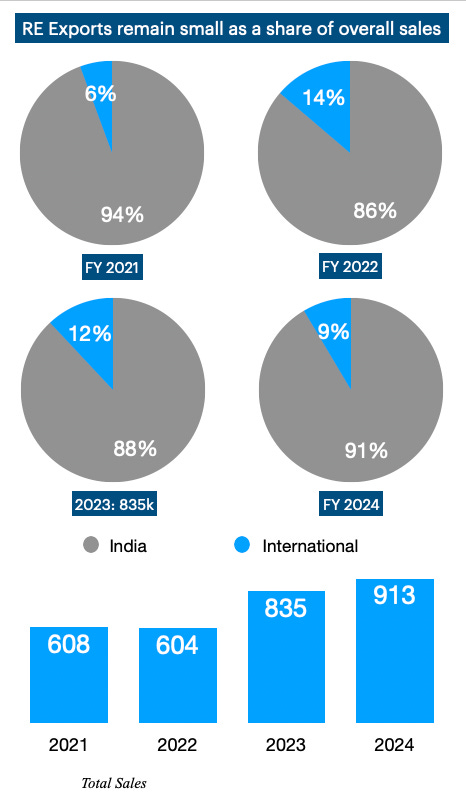
The EU is RE’s biggest international market and is not doing well. The launch of the Bajaj-manufactured Triumph 400s in the UK-EU markets has further compounded the situation. They have been received well, and the Speed 400 promptly won the MCN’s Overall Motorcycle of the Year award in August 2024. With Triumph rolling out two models on the 400 platform (and more expected to follow), with prices very close to REs in the UK-EU markets, the going is about to get tougher for RE.
And Triumph carries more halo than a Royal Enfield.
RE can do this with some help on the international sales front.
Is RE hitting a sales wall in India?
The most popular RE model retails in India at nearly USD 3000, while the most popular motorcycle in India—the 110cc Hero Splendor—retails at USD 1000. REs are mostly discretionary purchases in the home market. With 91 percent of sales coming from the Indian market, RE’s sales growth depends on the economy doing extraordinarily well in urban areas, which may fuel discretionary purchases.
RE’s parent company, Eicher Motors (which also sells heavy trucks), enjoys a 26-percent EBITDA margin. We cannot ascertain the margin on RE motorcycles on a stand-alone basis, but BoM cost estimates indicate an impressive 30 percent EBITDA margin.
That makes them a lucrative target for anyone who wants to improve profitability in the two-wheeler business. Recent attacks have come from Honda, Hero, Harley-Davidson, Bajaj-Triumph, and Classic Legends (Jawa, Yezdi, and BSA). Yes, that’s nearly everyone in the industry. RE is still the segment market leader in the Indian market, but the situation has changed from “ahead in a field of one” to “competition snapping at the heels.”
The range has to expand.
In such a competitive market, with global sales not moving fast enough, RE needs to explore market micro-niches where it may find a few thousand units monthly. The 13-motorcycle range is a misnomer. They are all different flavors of chocolate ice cream. Nearly every model targets the same core customer at different ticket sizes. RE does not even touch 80 percent of the Indian motorcycle market. It has to expand downwards (upwards is the glass ceiling of the Indian market). It plans to do that with the V platform, a range of single-cylinder motorcycles with 250 cc engines. That is likely to bring the entry price of RE motorcycles to USD 2400-2600 levels. More importantly, the customer base would expand towards younger and first-time buyers.
This works in India but has limited appeal in Europe, where a price drop of a few hundred Pounds is not expected to bring in a flood of customers. Competition is tough today but will likely get tougher tomorrow. RE needs a flanking strategy to tap into an entirely new customer base.
Enter the Flying Flea
An urban electric motorcycle with a daily commuting outlook and secondary highwayability is a lucrative proposition. Do it with some chutzpah, and the Europeans will lap it up.
When RE introduced the Flying Flea electric motorcycle sub-brand at EICMA, CEO Siddarth Lal emphasized that the new brand would open RE to a new customer base that it doesn’t tap today. In other words, he does not want Flying Flea to cannibalize RE ICE sales in any way.
It won’t. The RE designers and engineers have done a good job of differentiating.
Lal also emphasized the brand as a “City Plus” brand, avoiding using the words highways or motorways in his address. RE made it clear that the Flying Flea is a sub-brand with its own logo, and these are the first two motorcycles (C6 and S6) under it. More will follow.
The ‘C’ stands for Classic, and the ‘S’ denotes Scrambler. They chose the ‘6’ because a bigger bike could be 7, 8, or 9, and smaller bikes could take 1-5.
Flying Flea – the History
Let’s skip most of it for brevity, as enthusiast publications have covered it in detail. In short:
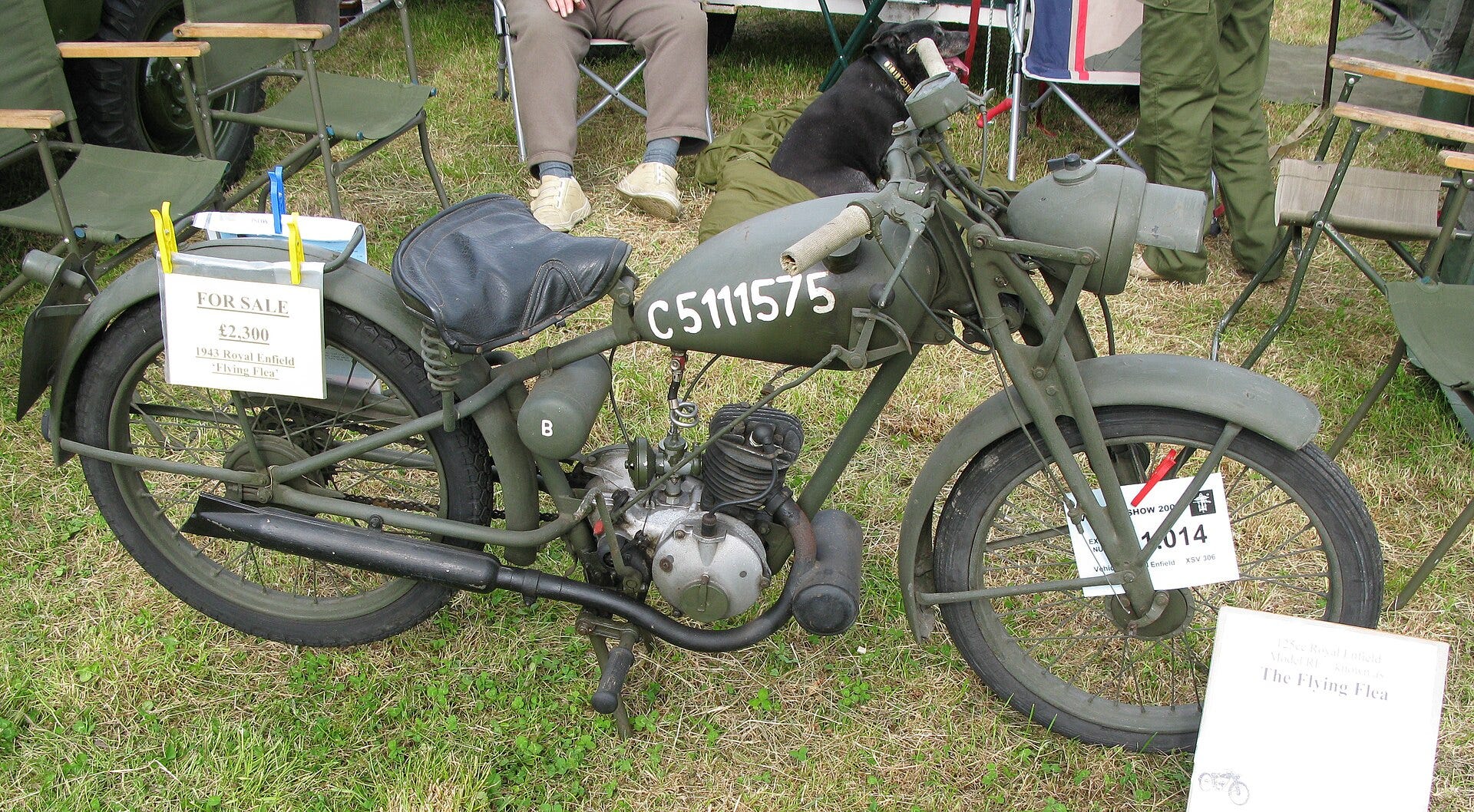
Flying Flea – Design Review
The designers of the Flying Flea have walked a tight line admirably. The bike maintains classic styling, yet it is directionally opposite of what Royal Enfield stands for. We think the top views compare things well.
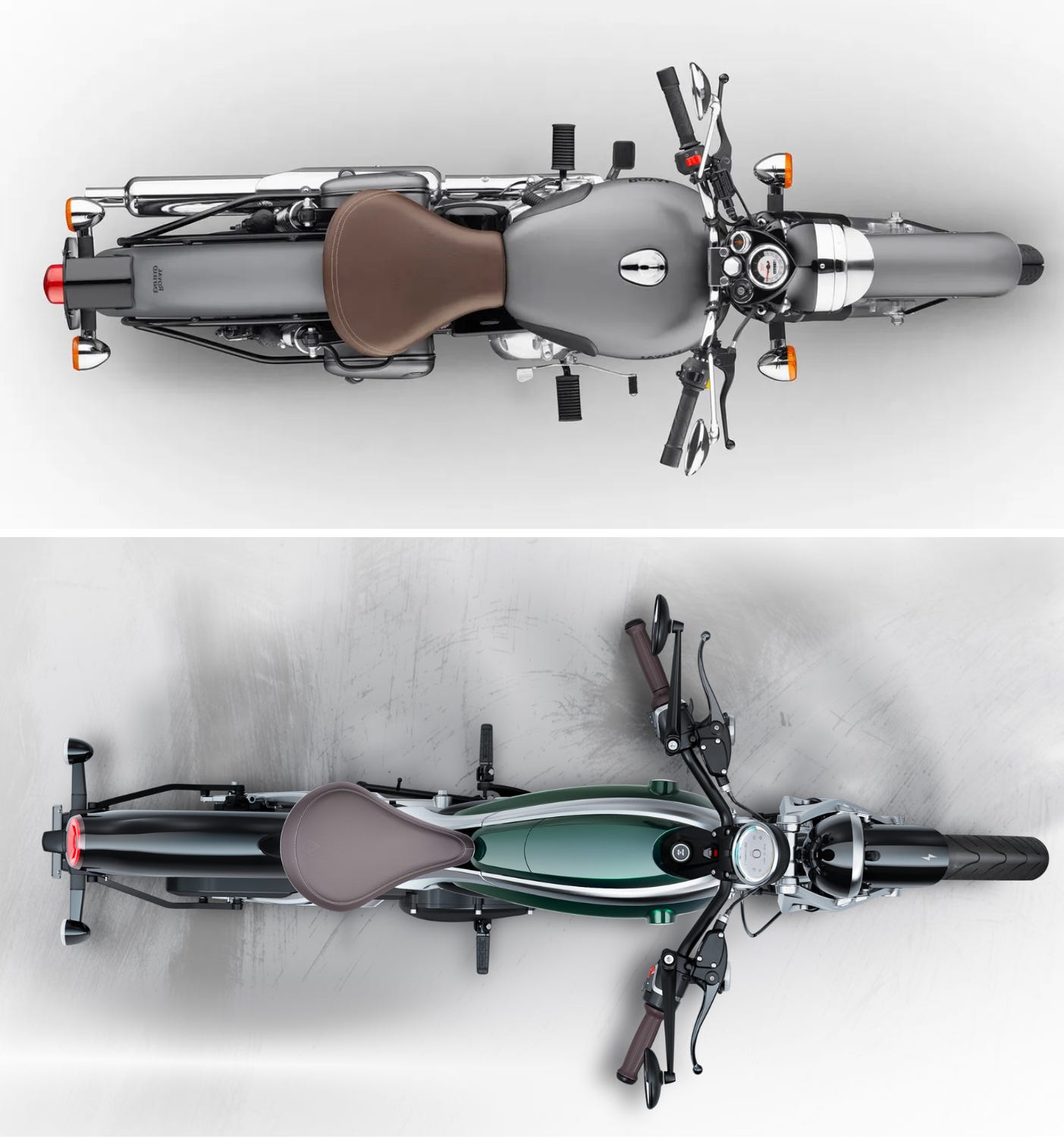
Then there is the front view.
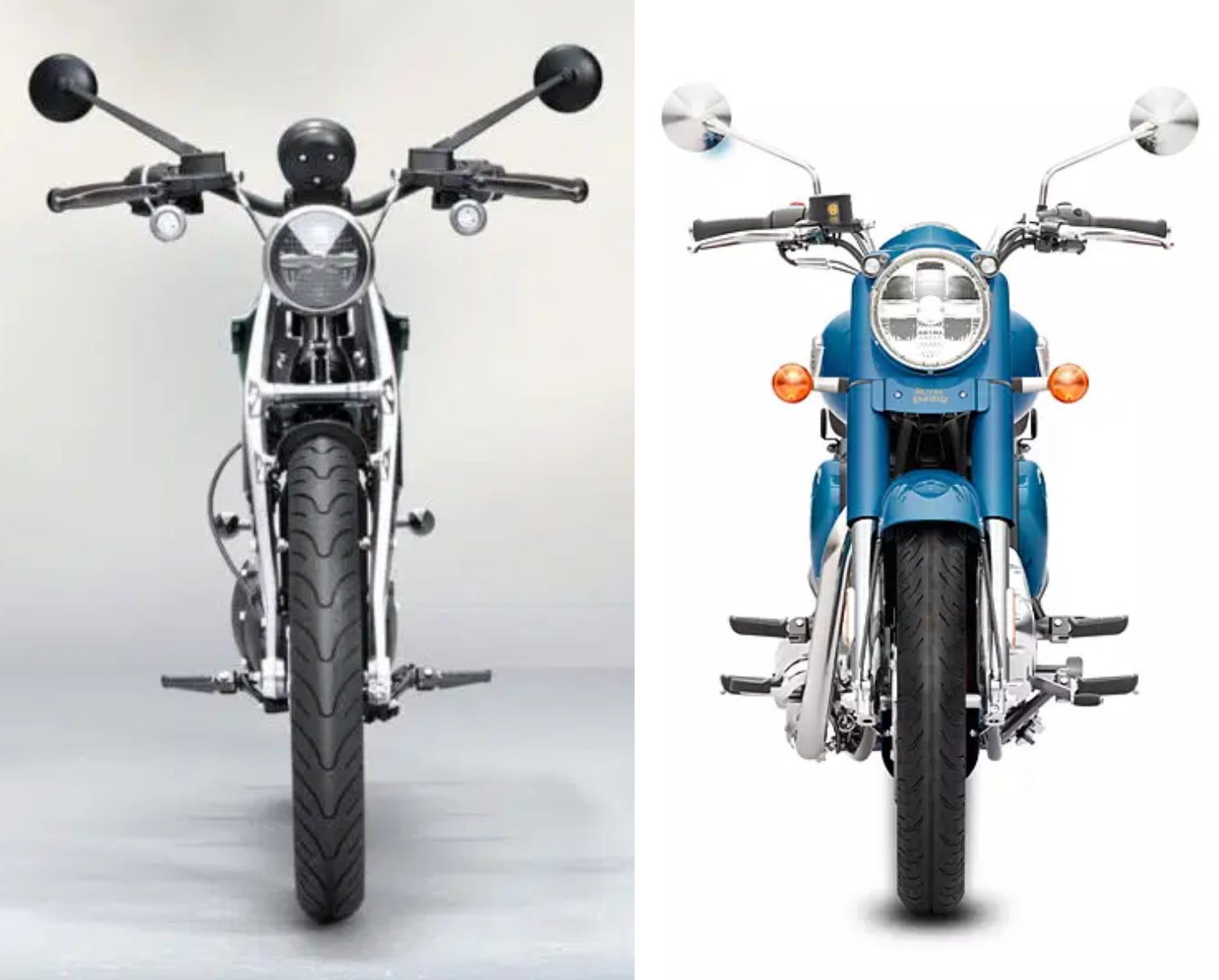
And the rear view
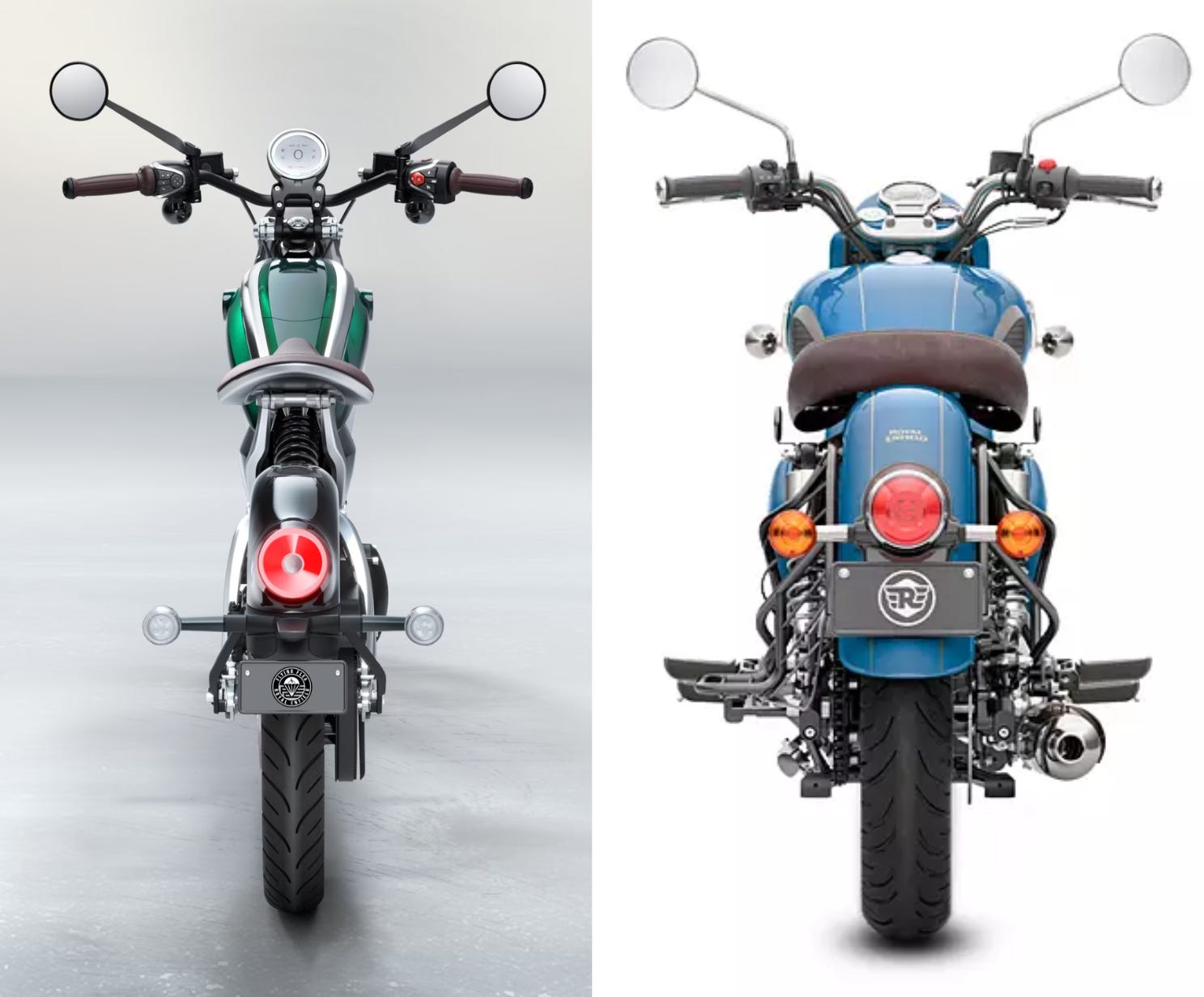
RE calls the design “retro-futuristic.” While the RE Classic is a brute beauty, the Flying Flea shows finesse and a sense of precision built into its components. Take, for example, the (unnecessary) girder forks below. It’s a precision forging with two jewel-like shock absorbers.
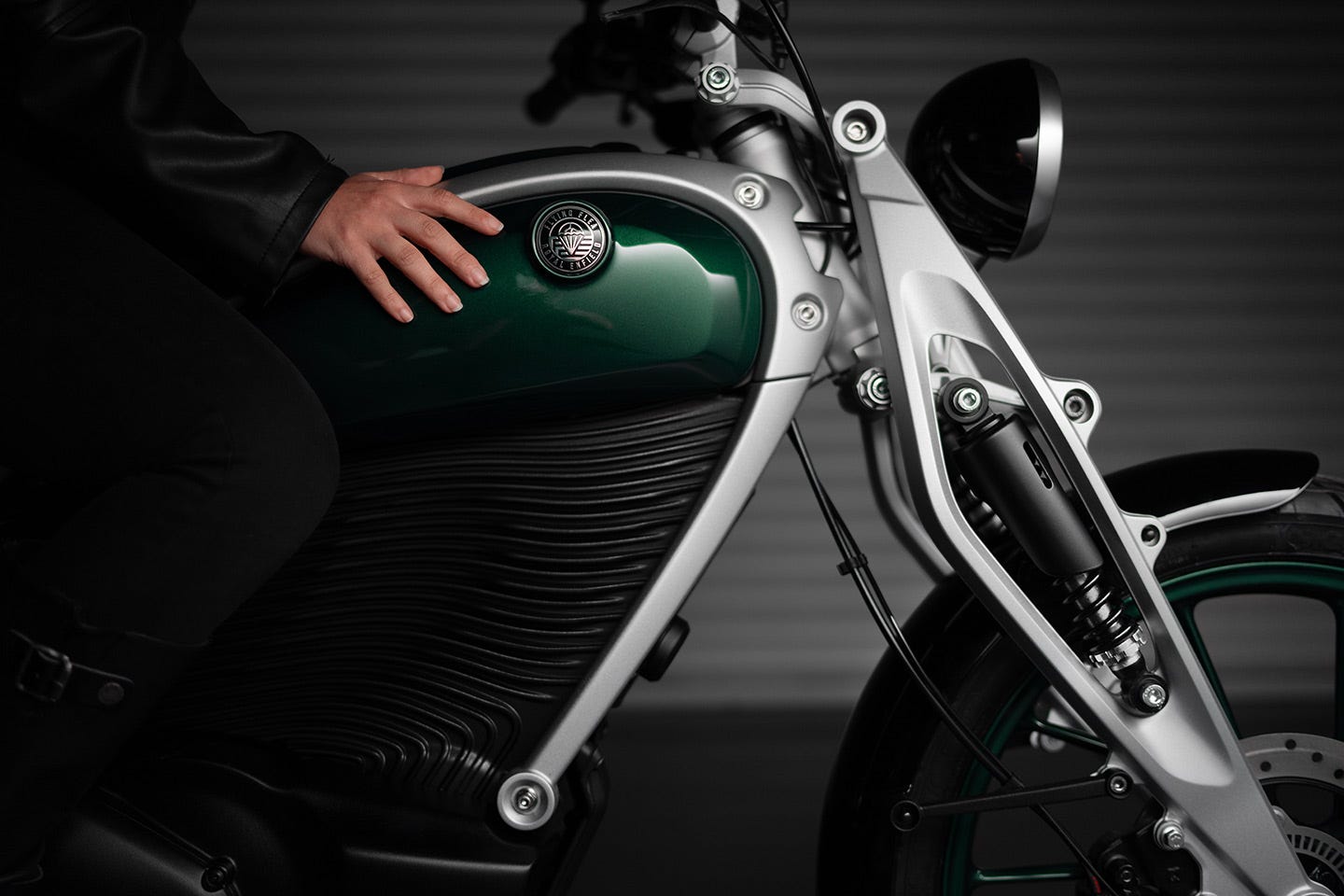
The bike is narrow, and the exposed forged aluminum frame is the prime design element. The frame wraps around the faux tank towards the front of the battery casing and connects to the single saddle (there is also a dual saddle variant) towards the back. The main frame, the triple clamp, and the front girder forks are all finished in brushed aluminum.
The design exudes a sense of lightness, which is difficult to achieve when designing an electric motorcycle, considering it has to carry a large battery pack. We estimate the weight to be about 110kg, which is not bad for an electric motorcycle.
On the mechanical side, the main frame connects to the front and rear of the motor and drive casing, which are structural elements. While everyone is making structural battery packs, RE has decided to sidestep it. Instead, the battery casing is a magnesium piece to keep the weight under check. This is a fixed battery.
Continuing RE’s tradition of using larger wheels, the Flying Flea C6 rides on 19” front and rear wheels. Those wheels ride on skinny tires, which means the motor is not very powerful, and the torque at the wheel is gentle. Skinny tires are a welcome choice as they would improve the range. Skinny tires are also part of the heritage, as the original FF looked like a bicycle with a two-stroke bolted on it.
The Girder forks
The girder forks have a reason—people should discuss them. So, we do. From a pure Newtonian physics perspective, they serve little purpose in a motorcycle that would likely have a 70 mph / 112 kph top speed. In addition, girder forks are complex, have linkages and bolts, and, unless not engineered well, would develop a play when used on bad roads (India!). It’s also a given that RE would be adding to the BoM cost for the novelty of having girder forks.
However, BoM cost does not seem to be a consideration for the Flying Flea. Creating a distinct and likable product seems to be, and that’s admirable.
The girder forks may be the talking point, but they are only on the C6 cruiser/bobber. RE also showed a scrambler model—the S6—with a conventional USD setup, even though the mainframe and other components remain the same.
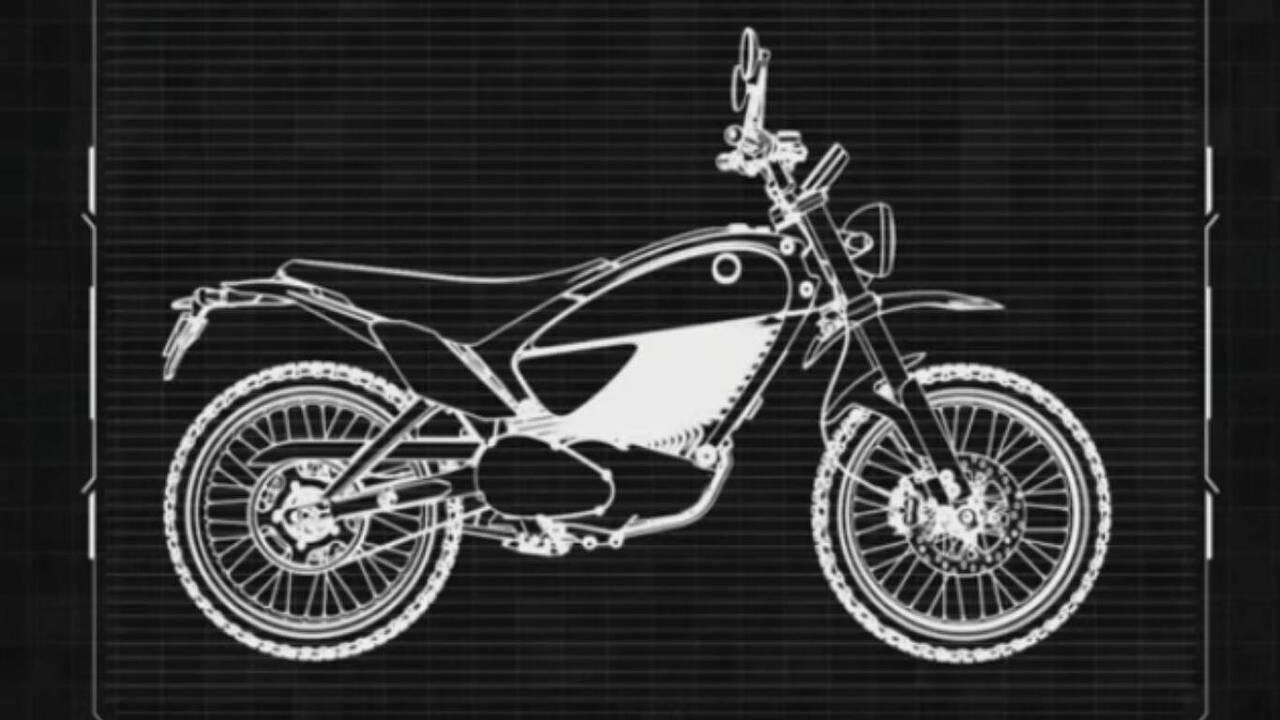
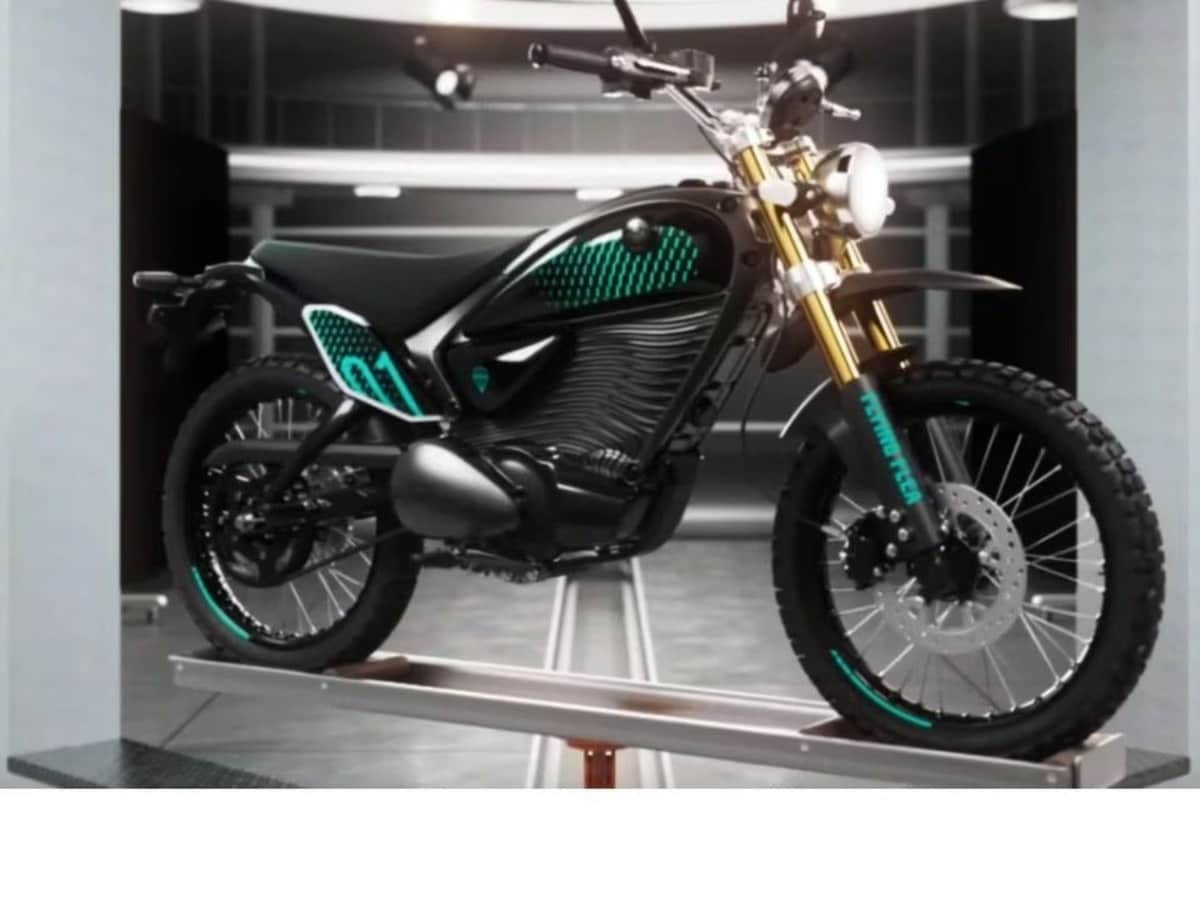
Specifications
RE emphasized that they are still ‘playing with things’ here, and the final specifications have yet to be decided. The motorcycle on display—the Flying Flea C6—had a 13 kW mid-drive motor from COMSTAR and a 6.5 kWh battery pack. RE promises an integrated charger, and a fast charger is likely also. It has been undergoing testing in Europe for some time now. However, RE refused to confirm the specifications.
If the C6 has a 13 kW variant, RE would also offer a sub-11 kW one to target learner’s license holders, the most lucrative market in Europe and North America.
The role of Stark
In December 2022, Royal Enfield invested EUR 50m in Stark Future, the Spain-based manufacturer of lightweight, full-size electric motocrossers. Since then, Stark has made a name for itself with the Varg motocrosser (non-street legal). At EICMA 2023, RE had displayed an electric concept on the Himalayan. This was a HV system and Stark has been working with RE on that. The company says that the Him-E continues to remain a test-bed and there are no immediate plans for a production program.
On the Flying Flea, a low voltage platform, there is very little contribution from Stark, unless there have been inputs on lightweighting.
Grand Strategy
Royal Enfield has taken its own sweet time in developing the C6. We estimate that the project started about five years ago. The company claimed 28 patents filed for the Flying Flea. The Classic looks may belie the tech packed in the FF – the C6 comes with cornering ABS and cruise control. Most impressively, RE says that the Flying Flea has 200k ride modes based on the combination of throttle, brakes, and regen. The brakes are from Bybre, Brembo’s affordable brand.
The strategy seems more grounded than grandiose. “Create a good-looking electric motorcycle that is unlike anything (except maybe the Maevings) on European roads,” seems to be the mandate. “To support your ambition, you can play with metals and metallurgy—aluminum forgings, magnesium castings, the works…”
There are no Gigafactories to manufacture cells and no massive in-housing of components. As of now, no vertical integration is planned. RE is content to follow the ICE strategy of assembling the best-fit components for the Flying Flea. That sounds old school, but that’s what RE is.

